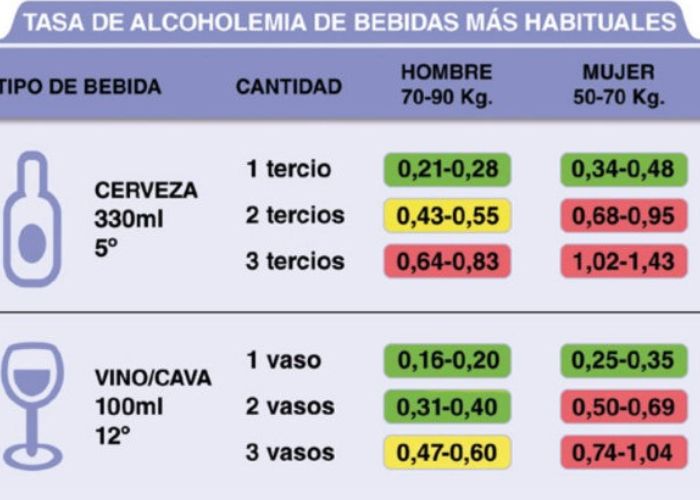MADRID – Drinking alcohol and driving do not go together, yet there are still many people who are not aware of this or who underestimate the risks. Alcohol is one of the most common factors in road accidents.
Furthermore, drinking alcohol and getting behind the wheel can lead to fines, loss of points and even jail time. As such, we will discuss the alcohol percentage allowed in Spain and the consequences of breaking these rules.
Maximum allowed alcohol percentages
The road safety law in Spain sets the maximum allowed alcohol percentages. The volume of alcohol in the blood is measured in grams of alcohol per litre of blood (g/l) or its equivalent in exhaled air.
For drivers in general, the maximum allowed percentage is 0.5 g/l in blood or 0.25 mg/l in breathed air.
For beginners and professionals, this is 0.3 g/l in blood or 0.15 mg/l in inhaled air.
Underage drivers, regardless of the vehicle they drive, must not have any amount of alcohol in their blood. This also applies to personal mobility vehicles such as e-steps (source).
Consequences of violations
If a driver tests positive for alcohol consumption, the penalties can start from a fine of €500 and loss of 4 points on the driver’s license (for a blood alcohol level between 0.25 and 0.50 mg/l). This increases to €1,000 and loss of 6 points (with a blood alcohol level higher than 0.50 mg/l).
If the offender is a repeat offender, the fine is €1,000 regardless of the alcohol content, while the number of points lost depends on the rate.
Crime
If the blood alcohol level exceeds 0.60 mg/l in breathed air, it is considered a crime. In this case, the sentences considered range from three to six months in prison, a fine of six to twelve months, a driving ban for a period of one to four years and between 30 and 90 days of work for the benefit of the community.
Refusing a breathalyser is considered a serious case of road safety violation. This may result in a felony and the same penalties as described above.
The negative effects of alcohol on driving ability are known, even with low consumption. The risk of a collision increases as the blood alcohol level rises. Not only does the risk of an accident increase, but also the risk of injury and the likelihood of death. Young drivers with less experience behind the wheel and who have consumed alcohol are particularly at risk.
How many glasses are you allowed to drink?
A schedule from the Spanish Guardia Civil provides information on the maximum amount of alcohol that drivers of different vehicles can have in their blood, indicating how many drinks one can consume to stay under the limit.
The schedule indicates that 70kg male drivers can drink, say, 2 pints of beer, 2.5 glasses of wine or 2 glasses of whiskey and still stay under the limit.
And, for example, female drivers weighing 60 kg, a maximum of 2 pints of beer, 2 glasses of wine or 2 glasses of whiskey applies.
It is important to note that there is a difference between men and women, as men’s bodies are generally slightly better at processing alcohol than women’s. However, it differs from person to person.
Take a taxi or walk
Of course, it is best not to drink alcohol at all before driving or operating any other vehicle. But, if you do decide to drink, make sure you don’t drink too much and take a taxi home or walk if possible.
Know that drunken behaviour on the street in Spain can also be fined. The same goes for drunk cycling. After all, you also participate in traffic on a bicycle and in most cases cycle on the street.
Also read: DGT launches summer campaign to raise awareness on alcohol-related traffic accidents


